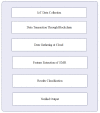Blockchain-Powered Healthcare Systems: Enhancing Scalability and Security with Hybrid Deep Learning
- PMID: 37765797
- PMCID: PMC10537957
- DOI: 10.3390/s23187740
Blockchain-Powered Healthcare Systems: Enhancing Scalability and Security with Hybrid Deep Learning
Abstract
The rapid advancements in technology have paved the way for innovative solutions in the healthcare domain, aiming to improve scalability and security while enhancing patient care. This abstract introduces a cutting-edge approach, leveraging blockchain technology and hybrid deep learning techniques to revolutionize healthcare systems. Blockchain technology provides a decentralized and transparent framework, enabling secure data storage, sharing, and access control. By integrating blockchain into healthcare systems, data integrity, privacy, and interoperability can be ensured while eliminating the reliance on centralized authorities. In conjunction with blockchain, hybrid deep learning techniques offer powerful capabilities for data analysis and decision making in healthcare. Combining the strengths of deep learning algorithms with traditional machine learning approaches, hybrid deep learning enables accurate and efficient processing of complex healthcare data, including medical records, images, and sensor data. This research proposes a permissions-based blockchain framework for scalable and secure healthcare systems, integrating hybrid deep learning models. The framework ensures that only authorized entities can access and modify sensitive health information, preserving patient privacy while facilitating seamless data sharing and collaboration among healthcare providers. Additionally, the hybrid deep learning models enable real-time analysis of large-scale healthcare data, facilitating timely diagnosis, treatment recommendations, and disease prediction. The integration of blockchain and hybrid deep learning presents numerous benefits, including enhanced scalability, improved security, interoperability, and informed decision making in healthcare systems. However, challenges such as computational complexity, regulatory compliance, and ethical considerations need to be addressed for successful implementation. By harnessing the potential of blockchain and hybrid deep learning, healthcare systems can overcome traditional limitations, promoting efficient and secure data management, personalized patient care, and advancements in medical research. The proposed framework lays the foundation for a future healthcare ecosystem that prioritizes scalability, security, and improved patient outcomes.
Keywords: IoT; blockchain; data storage optimization; decentralized applications; health system and access; homomorphic encryption; lightweight authentication; permissions-based system; smart city.
Conflict of interest statement
The authors declare no conflict of interest.
Figures




















References
-
- Ali A., Ejaz A., Jabbar M., Hameed K., Mushtaq Z., Akhter T., Haider A. Performance analysis of AF, DF and DtF relaying techniques for enhanced cooperative communication; Proceedings of the 2016 Sixth International Conference on Innovative Computing Technology (INTECH); Dublin, Ireland. 24–26 August 2016; pp. 594–599.
-
- Mushtaq Z., Sani S.S., Hamed K., Ali A. Automatic Agricultural Land Irrigation System by Fuzzy Logic; Proceedings of the 2016 3rd International Conference on Information Science and Control Engineering (ICISCE); Beijing, China. 8–10 July 2016; pp. 871–875.
-
- Hasnain M., Pasha M.F., Ghani I., Mehboob B., Imran M., Ali A. Benchmark Dataset Selection of Web Services Technologies: A Factor Analysis. Vol. 8. IEEE Access; Piscataway, NJ, USA: 2020. pp. 53649–53665.
-
- Ali A., Mehboob M. Comparative Analysis of Selected Routing Protocols for WLAN Based Wireless Sensor Networks (WSNs); Proceedings of the 2nd International Multi-Disciplinary Conference; Oxford, UK. 5–7 September 2018; p. 20.
-
- Ali A., Rahim H.A., Pasha M.F., Dowsley R., Masud M., Ali J., Baz M. Security, Privacy, and Reliability in Digital Healthcare Systems Using Blockchain. J. Electron. 2021;10:2034. doi: 10.3390/electronics10162034. - DOI
MeSH terms
LinkOut - more resources
Full Text Sources

